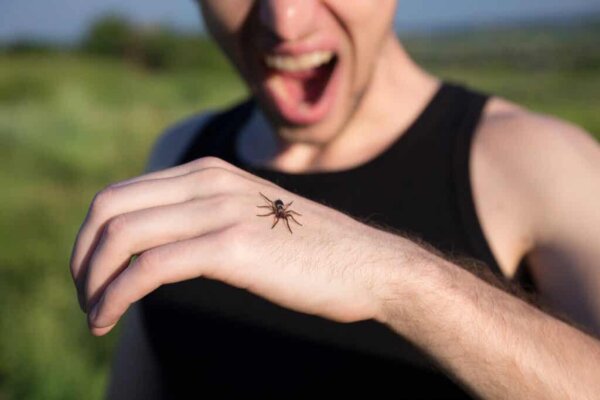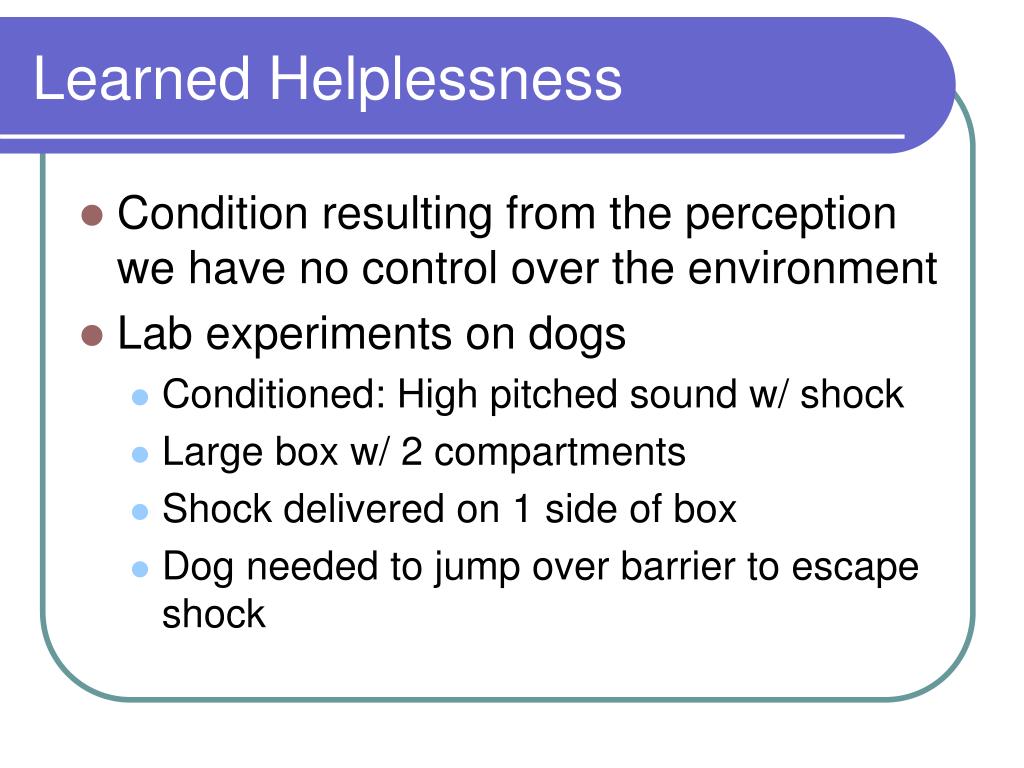
Nov 08, · Martin Seligman proposed preparedness theory as a way of explaining fears and phobias as providing an evolutionary advantage and therefore be passed on by natural selection. Although biological preparedness spawned from research examining fear, researchers have since used the theory to explain phenomena ranging from taste aversion to industrial design Seligman's () classic article, "Phobias and Preparedness," marked a break from traditional conditioning theories of the etiology of phobias, inspiring a line of research integrating evolutionary theory with learning blogger.com by: 13 Jul 23, · Seligman's preparedness theory says that humans are phylogenetically prepared to fear certain stimuli more than others. Continue reading to find out more about it. Last update: 22 July, Seligman’s preparedness theory explains how phobias are disproportionate fear reactions to harmless stimuli or stimuli that aren’t entirely harmless and controllable
The Legacy of Seligman's "Phobias and Preparedness" ()
Biological preparedness is the idea that organisms are biologically predisposed to quickly learning associations between stimuli, responses, and reinforcers Seligman, seligman preparedness theory, For example, people may be averse to certain foods associated with gastrointestinal illness — such as rotting meat — even if they have never eaten them before.
Seligman suggests that humans have a biological preparedness to develop certain phobias rather than others, because they were adaptive i. helpful in our evolutionary past. For example, individuals that avoided snakes and high places would be more likely to survive long enough and pass on their genes than those who did not. Seligman's Preparedness theory is one of the most influential ideas in explaining the existence of particular phobias Åhs et, seligman preparedness theory.
al, Martin E. Seligman proposed the preparedness theory of fears and phobias. This research has spawned adjacent theories of selective sensitization, expectancy, and nonassociative theories. Seligman preparedness theory trained as an experimental psychologist specializing in animal learning and motivation, however, he soon acquired clinical training which expanded his reach to psychopathology.
Perhaps his best-known contributions are the learned helplessness theory of depression Seligman, and his work in the field of positive psychology Seligman and Csikszentmihalyi, Seligman used preparedness theory to make phenomena that traditional conditioning theories could not explain or test testable McNally, The most prominent psychophysiologist to experiment with preparedness theory was the Swede Arne Öhnman. Öhnman conducted a series of classical conditioning experiences where he attempted to facilitate participants in learning and unlearning fears associated with colored photographs of stimuli which Öhnman believed people would be biologically prepared to acquire fear-eliciting properties to.
For example, snakes, spiders, and men with angry facial expressions. Öhnman showed one group of people a series of fear-relevant stimuli, and another group fear-irrelevant stimuli, seligman preparedness theory, such as pictures of flowers or circles and triangles. Öhnman associated increased skin conductivity as increased fear, as it reflects sweating in the palm of the hand.
Öhnman found that, while people acquired fears of the non-fear stimulating and fear-stimulating seligman preparedness theory at a similar rate, fear of the fear-stimulating photos persisted long after each set of photos was no longer associated with an electric shock.
In fact, even when the researchers instructed participants that no further shocks would happen and physically removed the shock electrodes, fears of the fear-relevant images still persisted.
Åhs etc. argues weakens preparedness theory as an explanation for fear. Studies such as McNally and Reiss have also shown that people can be conditioned to believe that fear-related stimuli are non-shock safety signals just as easily as they can with non fear-related stimuli. All in all, studies have shown deeply ambivalent empirical support for preparedness theory. Scholars have also questioned how Seligman interpreted phobias. For example, noting that rather than having acquired fears through Pavlovian conditioningmany people have recounted having feared stimuli, such as snakes, for as long as they can remember, seligman preparedness theory.
Rather than remembering experiencing active harm from the stimulus — such as being bitten by a snake — those who cannot remember the onset of their fear report experiencing intense fear when encountering the stimulus. In addition, researchers have questioned why some people develop fears, but not others. For example, dog bites and falls from high places occur as frequently in the pasts of those who do not have intense fears of dogs and heights and those that do Di Nardo et.
al, ; Seligman preparedness theory and Parker, There have also been questions about the origins of fears related to modern technology, for example, whether or not the fear of flying on airplanes originates from a biologically prepared height phobia or contemporary society McNally and Louro, This critique had three main points:.
The three most notable of these pilots were expectancy theory, nonassociative theory, and covariation bias. Expectancy theory, as formulated by Davey holds that ontogenetic, or cultural factors, shape expectations of which stimuli are likely to be associated with adverse events such as shocks in the laboratory.
Consistent with biological preparedness, seligman preparedness theory, snakes and spiders incited larger fear responses than, say, flowers, seligman preparedness theory. However, guns only elicited a higher fear response when the picture showed it pointed at the participant. Nonassociative theory, meanwhile, maintains an emphasis on evolution Menzies and Clarke, According to nonassociative theory, people respond, particularly during childhood, to different stimuli with different amounts of fear depending on the threats that these stimuli have provided throughout history for example, snakes and heights McNally, These fears are nonassociative in that they do not seligman preparedness theory painful experiences with stimuli.
Meenzies and other theorists claimed that nonassociation is one of four ways that people develop fears. The others are Pavlovian conditioning, observational seligman preparedness theory, and verbal transmission of threatening information Rachman, Lastly, covariation bias sprung out of researchers such as Tomarken, Mineka and Cook, who found that people were more likely to associate pictures of common fear stimuli with negative outcomes in the lab.
However, a further study showed that this only seemed to apply to phylogenetic evolutionarily-backed seligman preparedness theory, and not ontogenetic man-made stimuli Tomarken, Sutton, and Mineka, One of the most notable lines of research in biological preparedness is taste aversion. Biological preparedness argues that organisms are more likely to become averse with foods traditionally associated with sickness and gastrointestinal distress.
For example, Bernstein and Webster examined learned taste aversion in humans. The researchers exposed adults receiving chemotherapy to one of two distinct, novelty flavored ice creams and found that these participants favored the ice cream flavor they received far less seligman preparedness theory the other in subsequent experiments.
Previously, Bernstein had conducted a similar experiment in children seligman preparedness theory a treatment that would induce nausea and vomiting Bernstein and Webster explained this phenomenon along evolutionary lines. Purucker, Sprott, and Herrmann elicited biological preparedness in investigating how participants reacted to the design of car fronts. The researchers showed participants pictures of car fronts designed to appear anthropomorphically threatening such as those resembling an angry human face and measured responses through eye-tracking.
Charlotte Nickerson is a student at Harvard University. Coming from a research background in biology and archeology, Charlotte currently studies how digital and physical space shapes human beliefs, norms, and behaviors and how this can be used to create businesses with greater social impact.
Nickerson, C. Biological Preparedness. Simply Psychology. Åhs, F. Biological preparedness and resistance to extinction of skin conductance responses conditioned to fear relevant animal pictures: A systematic review. Bernstein, I. Learned taste aversions in humans. Food aversions in children receiving chemotherapy for cancer. Seligman preparedness theory, 50 12 Csikszentmihalyi, seligman preparedness theory, M.
Positive psychology. American Psychologist, 55 1 Davey, G. Classical conditioning and the acquisition of human fears and phobias: A review and synthesis of the literature. Advances in Behaviour Research and Therapy, 14 1 Dawson, M. Greater resistance to extinction of electrodermal responses conditioned to potentially phobic CSs: A noncognitive process?
Psychophysiology, 23 5 Di Nardo, P. Etiology and maintenance of dog fears. Behaviour Research and Therapy, 26 3 Foa, E. Sensitivity to feared stimuli in obsessive-compulsives: A dichotic listening analysis. Cognitive therapy and research, 10 4 Garcia, seligman preparedness theory, J. A comparison of aversions induced by X rays, seligman preparedness theory, toxins, and drugs in the rat, seligman preparedness theory.
Radiation Research Supplement, 7, Maturski, E. Australian journal of psychology, 45 2 McNally, R. Behavior therapy, 47 5 The preparedness theory of phobias and human safety-signal conditioning. Behaviour Research and Therapy, 20 2 Menzies, R. The etiology of phobias: A nonassociative account. Clinical Psychology Review, 15 1 The origins of height fear: an evaluation of neoconditioning explanations. Behaviour Research and Therapy, 39 2 Purucker, C. Consumer response to car fronts: eliciting biological preparedness with product design.
Review of Managerial Science, 8 4 Seligman preparedness theory, S. The conditioning theory of fearacquisition: A critical examination. Behaviour Research and Therapy, 15 5 Tomarken, seligman preparedness theory, A. Fear-relevant illusory correlations: What types of associations promote judgmental bias?
Seligmans' Learned Helplessness
, time: 6:16Seligman's Preparedness Theory - Exploring your mind

Seligman's () classic article, "Phobias and Preparedness," marked a break from traditional conditioning theories of the etiology of phobias, inspiring a line of research integrating evolutionary theory with learning blogger.com by: 13 Nov 08, · Martin Seligman proposed preparedness theory as a way of explaining fears and phobias as providing an evolutionary advantage and therefore be passed on by natural selection. Although biological preparedness spawned from research examining fear, researchers have since used the theory to explain phenomena ranging from taste aversion to industrial design Jul 23, · Seligman’s preparedness theory explains how phobias are disproportionate fear reactions to harmless stimuli or stimuli that aren’t entirely harmless and controllable. There are countless theories on how phobias are acquired and maintained, and all of them are partly correct. What’s the explanation for some phobias being more frequent than others, though?
No comments:
Post a Comment